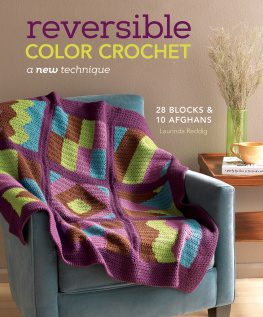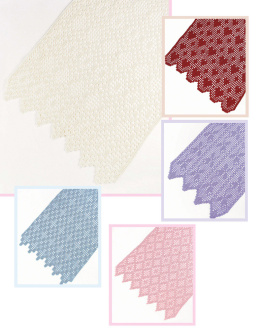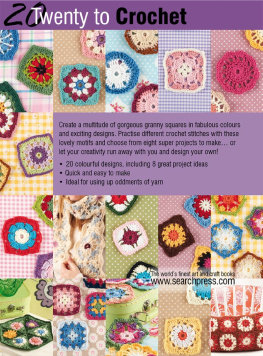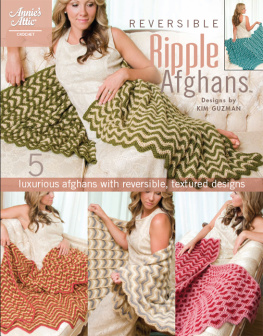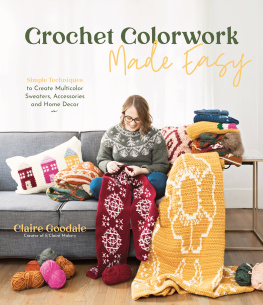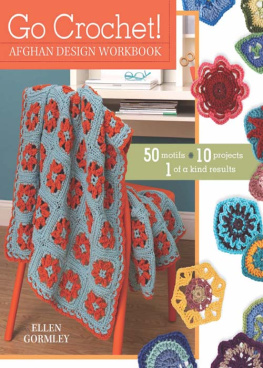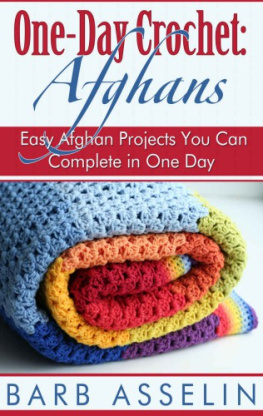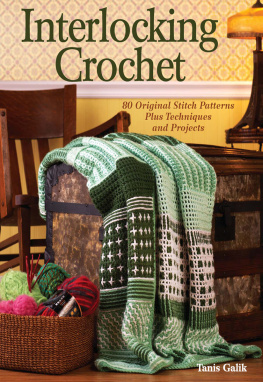Reversible Color Crochet
A New Technique
Laurinda Reddig

Contents
Introduction
In a craft that has been around as long as crochet, we seldom come across anything truly new. Though reversible crochet colorwork may not be a brand-new idea, the technique that I have developed is the result of many years of experimentation and adapting techniques learned from others. The result is truly reversible colorwork that is not stiff and produces clean lines, which allows for a wide variety of exciting designs.
I was first introduced to crochet colorwork through tapestry crochet. A friend from high school taught me to use multiple colors and carry the yarn under stitches. I began using the technique in my crochet, but I never liked the look of the carried yarns peeking through taller stitches (such as double crochet). Many years later, when I was expecting my first baby, my father decided to knit an afghan covered in tiny intarsia animals for his first grandchild. This opened my eyes to the possibility of having a separate ball of yarn for each section of color, rather than carrying the unused colors.
When my son was a little older, I decided to make him an afghan featuring a cartoon image that was created by using intarsia in crochet. Whenever I changed colors, I simply did what made sense to me and carried the old color up inside the stitches. Unlike knitting, the thicker stitches created by crocheted fabric make it easy to hide the strands of the unused color, making them reversible.
After my sons afghan won awards at the Crochet Guild of America (CGOA) Design Competition in 2011, other crocheters began asking for the pattern. As I consulted all of the books and experts I could find, I realized that my technique was indeed different than anything else available. I began to work on writing patterns and refining the details of the reversible intarsia approach. My Reversible Rowan Tree Vest, designed in memory of my first daughter, gave me the opportunity to hone the technique and won the grand prize at the CGOA Design Competition in 2012.
When I was just beginning to get my designs published, I took an online pattern-writing class to improve my skills. The instructor suggested that I submit designs and articles to various magazines to teach the technique. But no one project could explain the entire technique, so I developed a sampler afghan with squares that would gradually demonstrate all the necessary skills. That sampler idea eventually morphed into this book, and that same instructor became my technical editor.
With this book, you can learn to create beautiful, reversible colorwork by making just a few small changes in how you work the yarn before and after color changes. So get out your hooks and start playing with color!
Laurinda Reddig
Chapter 1
Getting Started
If you are reading this book, you probably already have some crochet experience, and you may be looking for a new challenge or, perhaps, a different approach to colorwork. Although the reversible intarsia technique presented in this book is not difficult (using half double or double crochet stitches), there are elements of the technique that will most likely be new to you. So, dont be tempted to skip over this first chapter, as it contains many tips and tricks, as well as the foundation information you will need to achieve fantastic reversible intarsia results.
How to Use This Book
This book is organized in a linear fashion, with twenty-eight squares that lead into ten afghan projects (each square is utilized in one or more of the afghans). The first twelve squares are the learning squares. They feature simple geometric designs and include extra information within the pattern text that will remind you when and how to make color changes.
Working through these first twelve squares is the best way to familiarize yourself with the technique. They slowly ease you into working with more and more colors and give your fingers a chance to learn the stitches unique to reversible intarsia. I have also included several tips and tricks to help you learn to work with the many yarn ends that result from all those color changes. Once you have a strong foundation with reversible intarsia, there are sixteen more squares to explore, featuring colorful quilt-, garden-, and space-inspired graphics.
The stitches that make this technique successful necessitated the development of a new language of crochet terminology. The ). In addition, each of the first twelve square patterns includes a list of the special stitches youll need for that particular square, along with helpful notes and reminders.
Youll also find handy stitch diagrams throughout the book that use the standard symbols for half double crochet, double crochet, increases, and decreases. The diagrams use different colors to indicate when to make a color change and whether that change should be at the end of a stitch, after the stitch, or right in the middle of the stitch. The diagrams will be very helpful as a visual plan to help you keep track of the color changes as you work.
Although Ive included ten afghan patterns to use the squares you create, there are infinite possibilities for combining squares and using your own favorite colors. I hope youll enjoy not only learning the technique, but also gaining the knowledge to create your own designs!
Tools and Materials
Here are some tips for choosing the right materials to get the best results from your colorwork.
Hooks and Other Tools
The great thing about crochet is that all you really need is a hook and some yarn. However, Ive also found a number of handy little helper-tools to go along with the basics.
Hooks: A gauge swatch, as described in each afghan pattern, will help you determine which hook to use for each project. You may need to adjust your hook size in order to get the gauge indicated. Use a larger hook if your swatch is smaller than the indicated swatch size or a smaller hook if your swatch is larger than the indicated swatch size.

